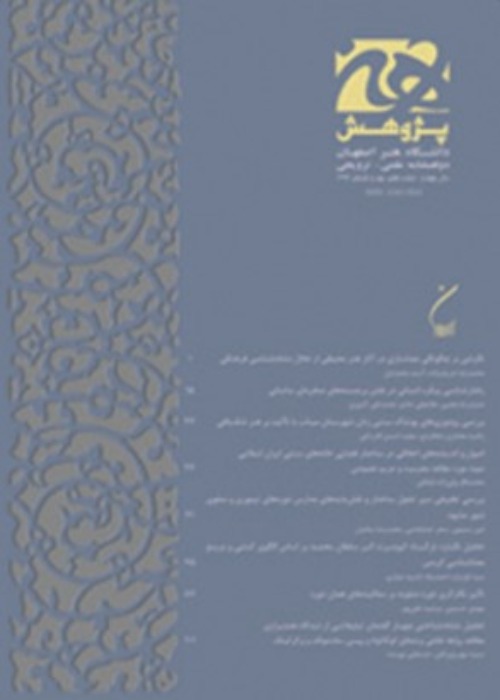The Comparison between Contents and Techniques of Inscriptions in Four Schools Belonging to Eighth Century in Yazd City
Author(s):
Abstract:
When most of Persian lands were suffering from insecurity and economical stagnations resulted from Mongol attacks, the Yazd city became the shelter of scientists, sufis and artists because of having Persian local government. Due to business boom, the city faced with many changes and basic attempts were done for constructing theological schools and monasteries. The establishment of various schools such as Rokniyeh, Shamsiyeh, Kamalieh and Hossainiyan can be pointed out as the most important fruits of those attempts. The mentioned buildings are valuable memorials from eight century that, due to their intact decorations, reliable data can be extracted from them. On the other hand, the study of unique architectural inscriptions of these monuments can guide us to a comprehensive plan of eight century art of “Katibeh-neghari-ye Memari” (making architectural inscriptions). Furthermore, it can provide answers to questions regarding materials and techniques, religious themes and decorative features of mentioned inscriptions.For these reasons, considering the valuable and exceptional opportunity which was provided to study these works (from near) during a time section, while proposing a brief introduction of the mentioned buildings, it is tried to investigate, record and compare the content of inscriptions as well as identify and classify the materials and methods used for making them in the four mentioned buildings. Techniques of inscription in the mentioned buildings include drawing, plaster work inside the building and tile-work outside the building, and the main decoration is calligraphy (writing inscription). Most inscriptions have Quranic verses and God’s names. The data of this research was collected via library sources and field studies and the method of research is descriptive-comparative. Before completing this article, it was probable that Naskh script was used in these inscriptions but the results of this study show that in such period the application of Kufic and Thulth scripts was current.
Keywords:
Kufic inscription , Thulth inscription , Yazd , School , Rokniyeh , Shamsiyeh , Kamalieh , Hossainiyan
Language:
Persian
Published:
Journal of Pazhuhesh-e Honar, Volume:3 Issue: 5, 2013
Page:
67
magiran.com/p1182835
دانلود و مطالعه متن این مقاله با یکی از روشهای زیر امکان پذیر است:
اشتراک شخصی
با عضویت و پرداخت آنلاین حق اشتراک یکساله به مبلغ 1,390,000ريال میتوانید 70 عنوان مطلب دانلود کنید!
اشتراک سازمانی
به کتابخانه دانشگاه یا محل کار خود پیشنهاد کنید تا اشتراک سازمانی این پایگاه را برای دسترسی نامحدود همه کاربران به متن مطالب تهیه نمایند!
توجه!
- حق عضویت دریافتی صرف حمایت از نشریات عضو و نگهداری، تکمیل و توسعه مگیران میشود.
- پرداخت حق اشتراک و دانلود مقالات اجازه بازنشر آن در سایر رسانههای چاپی و دیجیتال را به کاربر نمیدهد.
In order to view content subscription is required
Personal subscription
Subscribe magiran.com for 70 € euros via PayPal and download 70 articles during a year.
Organization subscription
Please contact us to subscribe your university or library for unlimited access!


